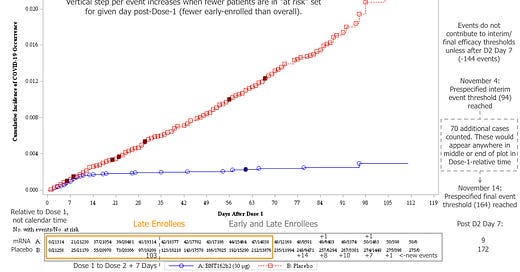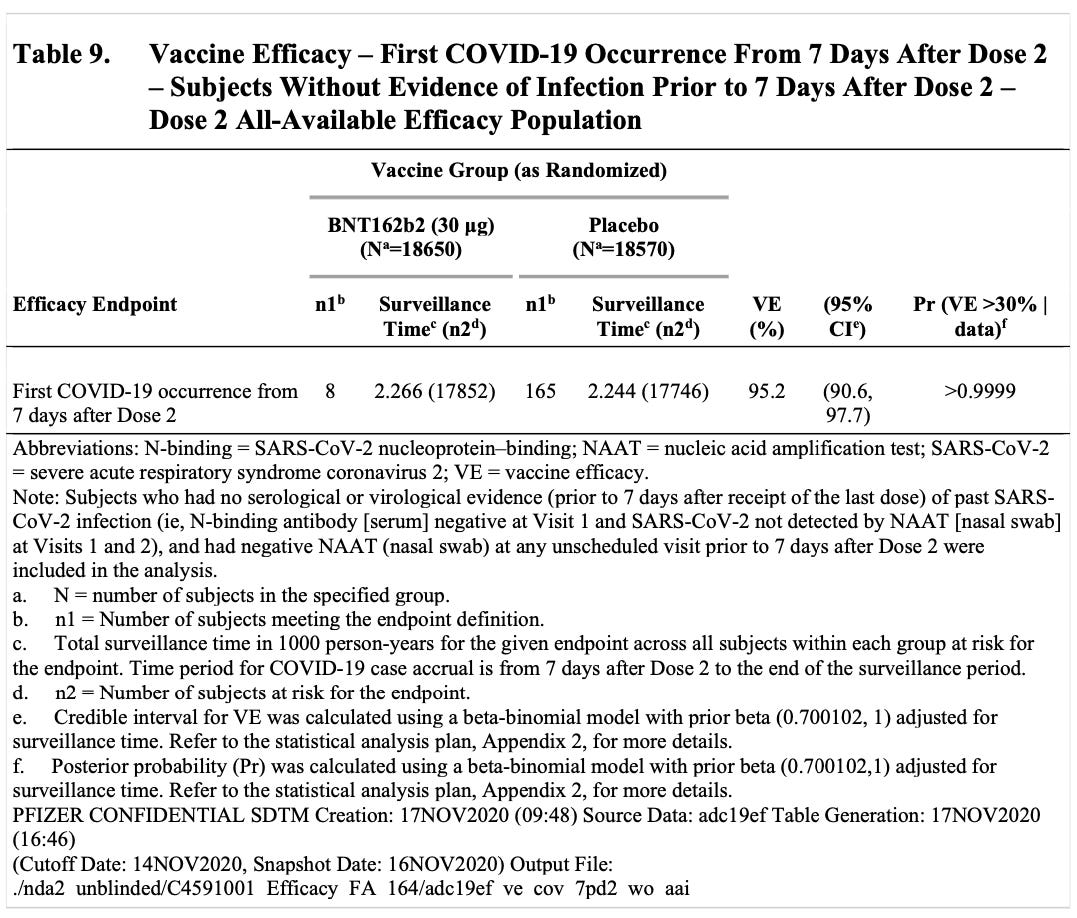Don’t Pfizer Me, Argentina
Thanks to my internet outage, I was all set to offer a belated early comment on the latest Pfizer trial controversy that leaned heavily on the analysis of a blogger of whom I am usually quite critical.
And then, I noticed an apparent error. And so suffice it to say I will be taking a much more cautious approach to the supposed evidence of Pfizer fraud in Argentina.
4444
First, here is “jikkyleaks” argument, via the blogger who goes by “el gato malo”s screenshot, accounting for the creation of a trial site with a weird number designation that enrolled a few final Pfizer Covid vaccine trial participants in late September, 2020:
This is not compelling. Whether site 4444 is fabricated or not, a “need” for cases in December could not somehow place trial operators in a bind solvable only by reverse-enrolling new participants, but also somehow limiting themselves to reverse-enrolling them right before the September enrollment deadline. This theory has the ring of being logical but is not actually logical.
But in expanding on “jikkyleaks” argument, “el gato malo” further appears to misinterpret the apparent surge in cases toward the end of the period as both corroborating this theory and being explained by it, unless I am misreading his argument (it is unclear how he derives his numbers).
placebo cases shot up in that last week racking up ~20% of total occurrence in the final 6 days of the 105 day period.
But in “plot time,” there is only 1 additional placebo case in the last 7 days, and only 17 in the 14 before then. The cases only appear to surge because there are fewer participants who had been enrolled for more than 84 days post-Dose-1. This is why the blue circles, even though they only represent one case each, also begin to “step up” a bit higher. But actual cases, numbered at the bottom, hardly increase at all:
Days are plotted relative to Dose 1, not in true calendar time. Note the lower numbers for “at-risk” participants in the higher day range - these days and the recorded cases plotted for them, although they likely occurred right before cutoff, are among the early enrollees.
Said cutoff was in November, not December. But a surge of cases somehow appended to late September enrollees in early December should have fallen around “Day 80” in the plot, not “Day 98 to 105.” And because of the higher number of “at risk” in those earlier post-Dose-1-days, assigning December or November cases to these participants would not have distorted the apparent event curve very much.
This would be true even if there were a mass dump of fake cases right before the cutoff (because of math, which is clearly evil).
The Pfizer Clinical Overview states that “Overwhelming efficacy success criteria on the first primary efficacy endpoint were met at the first planned interim analysis of 94 accrued COVID-19 cases as of 04 November 2020.” At this point, the bewildering statistical formulas declared that there was a 95% chance that the injection would demonstrate 30% efficacy against test-confirmed symptomatic infection (only for it to coincidentally go on to fake-demonstrate 95% efficacy, and real-life demonstrate 0% or negative efficacy against the same). Obviously the bewildering statistical formulas were wrong.1 But what is fairly intuitive is that there was no need to dump cases on the placebo group in the days after the interim analysis; all they needed was more cases of any kind, even if these reversed the trend. In fact, if they could have thrown in the 144 censored “worry window” cases between Dose 1 and Dose 2 + 7 Days, that probably would have got the statistical formula to pass them with flying colors!
Likewise, the Clinical Overview states that “The final efficacy analysis was conducted when at least the prespecified total number of 164 efficacy events accrued.” This was, in real calendar time, apparently November 14 - only 10 days after the 94 accrued events. But the approximately 7 tallied (mostly placebo) cases per day in this interval would have fallen all throughout the middle and end of the plot in post-Dose-1 time.
All of this is additionally visualized in my annotations above. See, especially, the small increases in absolute event counts in the higher post-1st-dose day range. Below, are all events at the final cutoff, confirming my math, I believe, followed by the way the events look in the efficacy analysis itself. In both cases the cutoff is November 14, when site 4444 participants would be at day ~55 post-Dose-1:
On the other hand, maybe I’m just too dense to get the actual math at work in “el gato malo”s argument, here. I mean the reader should be warned, I do not actually know the first thing about statistics, except that I don’t trust it. But if I don’t understand it, I’m not going to use it as a basis to allege fraud or even the apparent evidence of. Even if I think pharma probably does fraud all the time, especially RE vaccines (but wouldn’t claim to know first-hand).
What of the other apparent anomalies in the data from Argentina? Well, you can take the word of anonymous bloggers who allege first-hand experience with similar trial environments, but also seem to be making some really basic math errors lately, if you want. Personally I do not claim to know how weird or not-weird the Argentina enrollment seems.
For example, let’s imagine that it is incredibly difficult and therefor implausible for a real trial enrollment to roll so smoothly. The natural assumption would then be that these participant records were faked, and were entered… well, exactly how? By a human who physically sat down at a computer and invented random numbers, and yet somehow finished about the same amount of entries each day? By a computer script, that someone couldn’t bother to add an RNG into? It seems just as easy to actually round up a bunch of random souls to enroll in an already wantonly unethical trial for a rushed experimental drug, as to fake doing so with such even precision. Or, to fabricate this evidence with the intention of releasing it in the first place, to entrap hostile investigators into committing libel.
So whatever I think about the absurdity of expecting clinical trials conducted in every random corner of the Earth to not be a breeding ground for faked pharma data to begin with, I reserve judgement on the Argentina site, for now.
I may append some comments on the general limits that should be expected in looking for numerical evidence of fraud in the Pfizer trial (I think at most they are likely to be issues akin to the Ventavia vendor oversight scandal that is already in the open) later today. Click the title at the top, as always, to view the currently online version.
If you derived value from this post, please drop a few coins in your fact-barista’s tip jar.
The original email of this post had a confused treatment of the way the plot “goes up” here. Still working on cellular/mobile this week; forgive the poor editing. The removed portion:
Obviously the bewildering statistical formulas were wrong, but by my reading they still crossed this fake goalpost about “half-way” up the plot. At all events if there was a dump of day 98 events in early November, it ironically would have to have been applied to the earlier enrollees, not the late enrollees. This is further affirmed by lower numbers for at-risk participants in the higher day range - these days and the recorded cases are among the early enrollees.











I made it to your substack via comments on that “basic math error” on el gato malo’s page which was horrifying to me, a person with rudimentary statistical acumen. Many commenters clearly explained the error but no retraction occurred. I am not one to generally throw the baby out with the bathwater, but it’s hard to trust someone’s statistical analysis when they’re making errors that would be unacceptable in high school. And if I have to double check everything you’re writing, then I’m just wasting my time when I can be performing the analysis myself with whatever source material exists.
Like in every “community” there’s cliques, and it’s became very apparent who the in-group is in this topic. I am constantly checking myself that I’m not letting my non-conformist streak getting the better of me, but certain emerging narratives are reinforcing my lifelong aversion to groups. At some point, the members “evolve” from performing sanity checks to groupthink. I suppose it’s human nature… once we form trusting relationships, we become a bit lax in our reviews. It’s all sort of fascinating to watch this play out, as I suspect it’s the same dynamic that has occurred in the “mainstream”… the biggest conspiracy is the conspiracy of our own minds.
It seems to me that on "our side" most people seem to be binary thinkers such that if someone is giving me what I want to hear (whether I understand the science/data or not) then this person is my friend. "Banta" in your comments says that members evolve from sanity checks to groupthink. I think Banta is being generous; I don't think there was ever sanity checks. I think many people were anxious and frightened at the beginning of the scamdemic and as time went on they found various Twitters or Facebook or now Substack writers who could "explain" what was happening. I also think this was a good way for those who purport to be on "our side" to use their new platform to push other things. I consider The Cat to be a bit of a polemicist - most of his writing is on stirring up the herd. There is another writer I maintain reservations about who uses the scamdemic platform to post about another highly questionable subject.
I'm a fool me once person. We had/have in my state someone who showed up, first on Facebook and then when he got closed down enough times he established a MeWe account. He used his intellect and science background to explain what was happening in our state and explained the statistics and graphs, etc. All of this was good; however, it morphed into him joining forces with the election fraud racket and that became the focus of his writings. As I looked into his background (what there was), he became a "sketchy" character in my book. I tread very, very lightly when commenting on his MeWe account so as not to show my hand (he had a lot of admins), but they must have sensed a pattern (LOL!) and I was banned for using an emoji (a show of support for another commenter).
Anyway, I beg your pardon for this lengthy comment. I just wish that all of us who are rightly skeptical of these past two years would hold on to that skepticism about everything. Stop looking for the "good" guy or someone who is going to stand up to TPTB. I maintain that attitude about everyone I read and I'm always boggled when someone's "good" guy is criticized and his supporters jump all over the one daring to criticize. A true believer is not the mindset you want to be in. You will be taken in again.